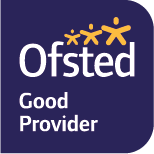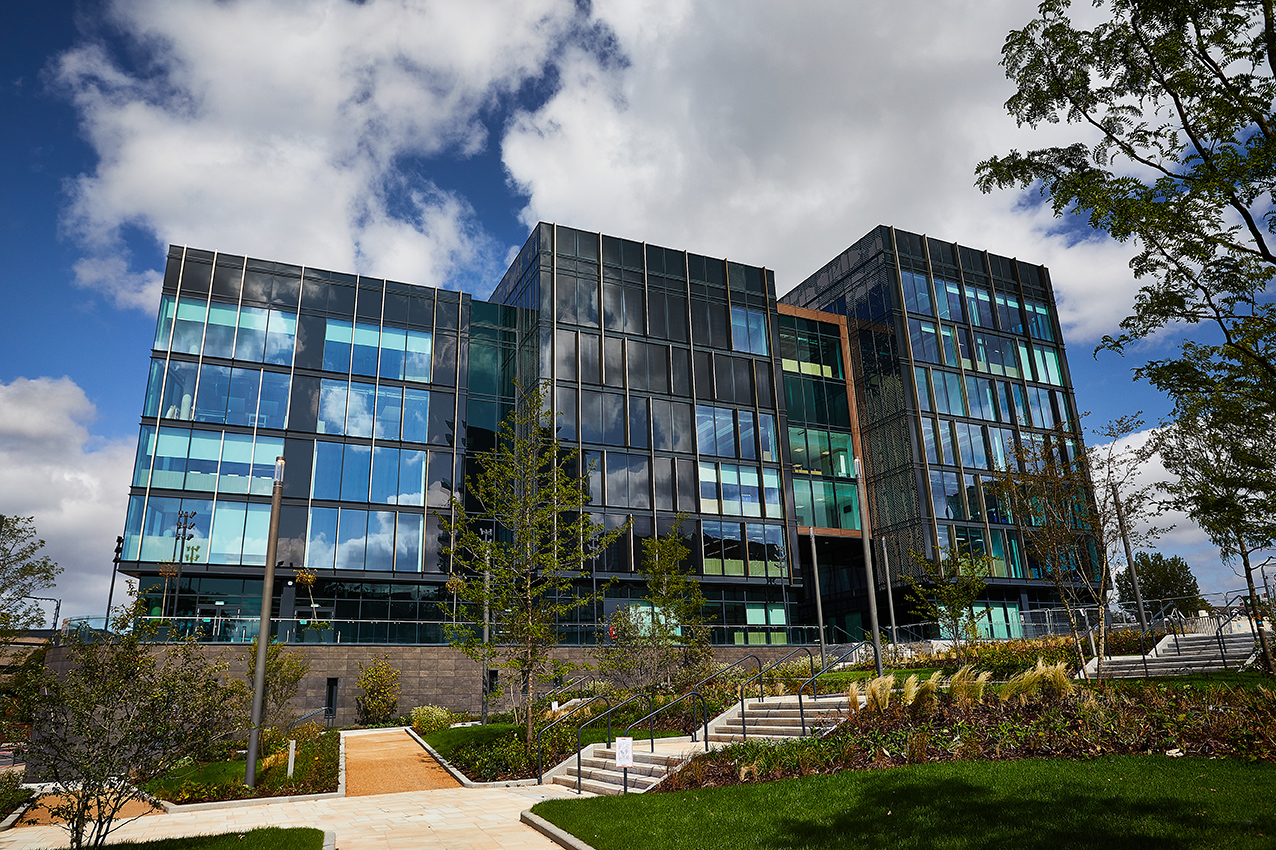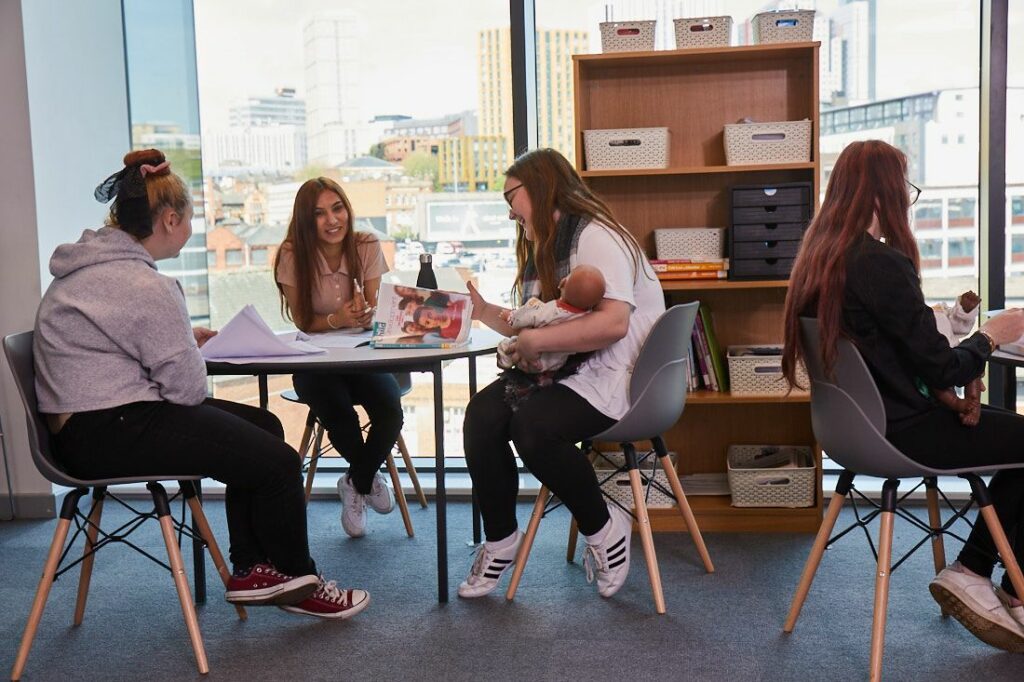Interviewees – Kirsty Smith. Programme Manager, Education & Childcare (SPEAKING) / Katie & Niamh. Level 1 Students – Education & Childcare
(SPEAKING) / Tania Purchase. Programme Manager – Education & Childcare (SPEAKING) / Emma Langford. Interim Head, Department of Education and Childcare (SPEAKING) / Emma Hird. Teacher – Education & Childcare (SPEAKING) / Ester Montaner. Programme Manager – Education & Childcare (SPEAKING) /
Music – A pop-rock instrumental with a guitar solo plays.
Scenery – The camera flashes through footage of: a learner pulling a blue VR headset over their eyes; a fluffy brown dog licking a learner’s nose; learners holding and bottle feeding dummy babies; a learner shaking sugar into a mixing bowl; learners laughing while touching their heads then shoulders; learners laughing and lifting a play parachute. The screen fades until fully green and a white logo appears in the centre with text that reads “School of Social Science. Leeds City College”.
Song lyrics – “Cos I know we are the shape of things to come.”
Music – An uplifting, poppy instrumental with acoustic guitars.
Scenery – A man with short brown-grey hair, with no hair around the crown, writes on a whiteboard and laughs. He has a pale warm-toned complexion and wears a dark blue shirt. Cut to a learner wearing a light grey fleece with auburn hair in a bun and a pale, pink complexion laughing while typing on a laptop. Cut to a woman sitting in a light, airy room. She has light, centre-parted blonde hair and a fair, rosy complexion. A green banner appears with white text that reads “Kirsty Smith. Programme Manager, Childhood & Education”.
Speaker: Kirsty Smith – “Before I started working at Leeds City College, I worked in a number of earlier settings, so the main part of my career was in the NHS working as a hospital place specialist, and then I’ve also been a registered child-minder and owned my own nursery for 15 years…”
Scenery – Cut to a learner with blonde hair and a pale complexion sitting at a wooden desk and smiling while writing. The camera zooms in to show him working on calculations, with fractions visible on his paper. Cut to a tutor with warm olive skin, black glasses, a face mask and a taupe hijab. She speaks to an off-screen class while pointing at a screen. Cut to large circle tables divided by clear, vertical perspex screens. Three learners face each other while working on laptops and notebooks. Cut to a student with a deep brown complexion, black type 3 hair and a light blue lanyard over a mesh and patterned black top. She looks focused as she types on a black and green HP laptop. The camera cuts back to Kirsty.
Speaker: Kirsty Smith – “All that experience is what works here and helps you become a good teacher because you can pass all the knowledge and experience on.”
Scenery – Cut to two learners sitting next to each other, carefully holding dummy babies in their arms and practising bottle-feeding them. The learner on the left has a rosy white complexion, brown hair with red highlights and black glasses; the learner on the right has long dark brown hair in a middle parting and a fair cool-toned complexion. The camera cuts to two learners sitting towards the camera, in a light room with window panels behind them. The student with red highlighted hair sits on the left. On the right, a student with a pale peachy complexion, long blonde hair and blue glasses propped on her head speaks. They both hold dummy babies. A green banner appears with text reading “Katie & Niamh. Level 1 Students – Childhood & Education”.
Speaker: Katie – “This one’s Sammy.”
Speaker: Niam – “This one’s Davies.”
Speaker: Katie – “Um, they give us them to help us to understand what it’s like to actually look after a child, and so that we actually have some experience when we do go into a setting.”
Speaker: Niam – “I think a lot of it’s about, obviously, so much responsibility looking after children, cos’ they’re so vulnerable. So, like, looking after them, like before, when they’re not real babies – is super helpful…”
Scenery – Cut to Katie holding a dummy baby and laughing with it in her arms before holding a bottle to its mouth. Cut to a close-up of Niamh holding the dummy baby’s hand, which rests between her index and middle finger.
Speaker: Niam – “When you switch them on, and they start crying at absolutely everything, it’s so difficult to work out what they need, like, if they need the nappy change and if they need cuddles or, like…
Speaker: Katie – “they just need…”
Speaker: Katie and Niam – “feeding…”
Speaker: Niam – “It’s so difficult to, like, work out what they need. And obviously, that is, like, such a shock to the system because you don’t realise how needy babies actually are.” [Niamh giggles]
Scenery – Cut to a learner with long, light blonde hair and a turquoise lanyard, smiling as she holds a dummy baby. The camera pans to show another learner carefully holding a baby. The camera zooms in to focus on the dummy baby. The baby has deep, tanned skin, black hair, and a pink and white chequered babygro. The camera cuts to a woman with dark brown hair tied with a neat side parting, a rich tanned complexion and dark brown eyes. She speaks enthusiastically. A green banner appears with white text that reads “Tania Purchase. Programme Manager – Childhood & Education”.
Speaker: Tania Purchase – “We provide education for-for a diverse, um, sort of community. So we’ve got people from all walks of life, from different backgrounds – but it’s like one big family here at, erm, Quarry Hill. The students come, they all get on with each other, they all, I guess, become restorative and resilient in what they do…”
Scenery – Cut to a row of learners seated next to each other, laughing, chatting and smiling as they manipulate and work with red and yellow sand clay. The camera cuts to a woman with a fair, tanned complexion and shoulder length brown hair speaking directly to the camera. A green banner with text reads “Emma Langford. Deputy Head of Childcare and Public Service” appears.
Speaker: Emma Langford – “I absolutely love our Quarry Hill campus. I love the feeling of it, the-the nurturing feeling of it, the respect that the students give to the…each other and to the campus. It’s got a really nice calm feeling when yo-you’re walking around the campus…”
Scenery – Cut to a group of students standing outside, watching and following tutors do ‘heads, shoulders knees and toes’. Cut to a student walking towards a teacher in a bright classroom, taking papers from her and turning around. Cut to a close up of students clapping and looking towards someone off-scree.
Speaker: Emma Langford – Our students are really helpful, they say “hello” to you , “good morning”, “good afternoon”. There is a level of respect at this campus.”
Scenery – Cut to a student with long dark blonde hair, looking up from her laptop while raising her hand and smiling. Cut to a student giving a treat to a fluffy cocker poodle and smiling as she speaks and strokes the dog’s head. The camera cuts to a woman with a pale, pink-toned complexion and wavy blonde hair. As she speaks to the camera, a green banner appears with white text that reads “Emma Hird. Teacher – Childhood & Education”.
Speaker: Emma Hird – “So, we do outside story time as part of a, kind of, collection of things that we do within English to try and make what we’re doing in GCSE English relevant to what they’re doing in their placements and what they wanna do as their careers. So actually seeing storytime is something they’ll be doing, probably, every day. Erm, and that’s English, and that’s reading, then that’s kind of a nice way of doing it.”
Scenery – Cut to Emma and a group of learners sitting on a lawn in the campus gardens. Emma holds a picture book and speaks as the learners smile and make gestures that mimic the fish and underwater imagery visible in the book. The camera cuts to a woman with long reddish-brown hair, a fair warm-toned complexion and blue eyes. A green banner reads “Ester Montaner. Programme Manager – Childhood & Education”.
Speaker: Ester Montaner – “Here at Mabgate, this is an amazing campus that college is developing and, we are, [she gestures around her] as you can see, we have lots of different physical activities, erm, resources, and areas so our students can make the most of it. We’re always trying to link things with the national curriculum, so, for example, PE is a big part in the national curriculum and it gets reflected within our courses that we’re developing…”
Scenery – As Esther speaks, snippets of her tutoring a class of learners in a large gym and fitness setting plays. It includes: Ester moving into downward dog and yoga positions as the learners follow; Ester speaking, smiling and making shoulder-posture gestures as a tutor sits beside her and mimics her movements; the group sits in a circle, engaged in conversation.
Speaker: Ester Montaner – “So in here, you can see that there’s lots of equipment and lots of things for students to develop these skills.”
Scenery – Cut to different equipment areas in the fitness space including: a weight-lifting area with a seated bench, barbells, weight disks and a dumbbell rack; tall metal standing frames with TRX cables hanging from them. The camera cuts back to Katie and Niamh who sit with their dummy babies on their laps.
Speaker: Katie – “The benefit of the creative stuff is just… learning different activities that you could do with the children when you’re in the setting or learning what activities they actually like to do, or they prefer to do, that’ll actually help them with the development…”
Speaker: Niam – “The facilities like with the kitchen are so great because you get to learn about what nutrition that children need, and you can make at home yourselves to, like, look after the children or even in the nursery sort of, making different things for lunch and snack time…”
Speaker: Katie – “You can even use it as different activities to do with the children, so, like making buns with them.”
Scenery: As Katie and Niamh speak, the film shows four learners preparing food and working together in a clean, bright kitchen environment. Wearing pinstripe green and white aprons, they individually chop onions, stir ingredients in glass bowls and chat and laugh together while preparing. The camera focuses on a close-up of fair, pink-toned hands smoothing cake batter in a black loaf tin. The camera then cuts to a learner with rich tanned skin, black hair and brown eyes holding the corners of a play parachute. The camera cuts back to Childhood & Education teacher, Emma Hird.
Speaker: Emma Hird – “Um, so the parachute’s a really good way of getting everyone to interact with each other which is exactly what they’re gonna be doing with children of any age, erm, whether that be in school environment or a nursery environment. And it’s just a really nice, positive thing to do and to get involved with outdoors, so we link to lots of forest schools and things like that as well.”
Scenery: As Emma speaks, we cut to footage of learners playing with the play parachute on the campus grounds. They lift it, lower it to the floor and shake it together while laughing and smiling. The camera cuts back to Katie and Niamh.
Speaker: Niam – “The headsets are super useful because a lot of us, we’ve come straight from high school, and we haven’t seen what it’s like to be in a nursery and, like, looked around, so I think, getting to see what it feels like in person is so great because you get to explore the different areas that might be in your nursery when you go into placement.
Scenery: As Niam speaks, we cut to footage of learners wearing VR headsets while standing in a classroom while students holding babies in the background. The headset users hold remotes in their palms and click to control their virtual environments. A learner smiles as she places a headset over her eyes. The camera cuts to Ester, who now speaks in a new, classroom-based environment. She also wears different clothing and a bright orange shirt.
Speaker: Ester Montaner – “Now, this year, we’re very lucky as well because the government is bringing in T Levels, which is made us reshape the whole of the curriculum and look at it with fresh eyes. Erm, we’ve looking at experience, seeing what’s happening in schools, what’s happening in nurseries, so we can teach it here, bringing things like technology, erm, national curriculum, the-the new LEAS foundation stage and make it more up-to-date, erm, just to make sure that when students complete the qualifications and they go all – you know – on to employment, on to the next course, they’re ready for it.”
Scenery: As Ester speaks, the film cycles through footage of Childhood & Education learners as they learn and take part in related activities. A light blue flyer with fried egg-illustrations has black text that reads “Childhood & Education. Rise & Shine. it’s Breakfast Club”. The camera focuses on a large dish of pastries as a hand reaches in to grab a croissant. Cut to learners as they carefully create bracelets, using brightly coloured beads and pliers. The camera cuts back to Childhood & Education Programme Manager Tania Purchase.
Speaker: Tania Purchase – “I guess why I’m still here at Leeds City College is seeing that progression and seeing that growth in our students. And even now when I’m out and about, and I can see them in practice, and they’re qualified, and I’ll be going to my students who are putting them through the training – I’ll be going to them and getting feedback from them, with regards to students with training now. So just to see that growth and achievement and success and-and even if it’s not always about academi-academic abilities, it’s about those life skills.”
Scenery: As Tania speaks, the film shows clips of Childhood & Education learners thriving in their learning environments, caring for dummy babies, applauding peer work in a classroom setting, and sitting in a circle and bonding. The film slowly fades to an all-green screen before a white logo appears with text that reads “School of Social Science. Leeds City College”.
Music – The uplifting, poppy melody fades to silence.




Follow us on Social Media